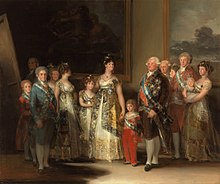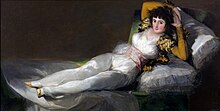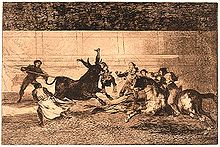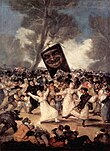Francisco de Goya
Francisco José de Goya y Lucientes (born March 30, 1746 in Fuendetodos , Aragón , Spain , † April 16, 1828 in Bordeaux ) was a Spanish painter and graphic artist of the late 18th and early 19th centuries.
life and work

Francisco de Goya was the son of the respected gilders José de Goya († 1781) and the impoverished country nobility Gracia Lucientes y Salvador. He was the fourth child after two sisters and a brother; two other brothers followed after him. The eldest, Tomás, later took over the father's workshop. The collaboration of the gilders with painters, sculptors and carpenters in the production of ecclesiastical retables had declined because these baroque works no longer corresponded to contemporary tastes. As a result, Francisco had to learn a different trade, because his father's workshop could not provide him with any additional income.
Goya therefore had lessons from the baroque painter José Luzán in Saragossa from 1760 and later worked mainly in Madrid . In 1773 he married Josefa Bayeu there. Between 1775 and 1776 he designed models for the royal carpet manufacturer Santa Bárbara in Madrid and was later appointed academy professor. In the 1770s he made the acquaintance of Luis de Borbón y Farnesio , brother of the Spanish King Charles III. , whose family members he later portrayed several times. In 1786 he entered the service of Charles III as a court painter. and from 1788 to Charles IV. His "ascent" was by no means smooth, but was caused by constant arguments with the Academia San Fernando , to which he applied several times without success, other court painters, especially with his brother-in-law Francisco Bayeu, and wrestling Orders shaped.
He created religious frescoes , for example for the Basílica del Pilar in Saragossa , and some altarpieces influenced by Giovanni Battista Tiepolo's painting . A little later he was recruited by Anton Raphael Mengs to work as a painter for the royal tapestry workshops founded by Mengs . The designs for the carpets show traditional Spanish scenes and thus begin to soften the Rococo tradition. Numerous portraits were created for the nobility, such as the painting Portrait of the Marquesa de Pontejos from 1786, and for the Spanish royal family.

The family of Charles IV. , Originated in 1800, is surprising as particularly ruthless in its realistic depiction . A contemporary critic said that the king (6th from right on the painting) and his wife (8th from right) “looked like like a baker and his wife after winning a lottery. ”In terms of art history, the painting is to be seen in connection with the work Las Meninas by Goya's famous predecessor Diego Velázquez . Like Vélazquez, Goya also portrays himself in the picture behind his easel as a subjective observer of the king's family at court.
In 1792 Goya became seriously ill, resulting in lifelong deafness . For speculation and myth-making, not least in the novel Goya or the evil path of knowledge of Lion Feuchtwanger processed, made his supposed love affair with the Duchess of Alba , which he portrayed several times . However, very few meaningful sources have survived on this subject.

In the 1790s, a turning point in his artistic work can be recorded. Goya's art was no longer aimed solely at the courtly environment and its desire for representation. He slowly retired from his public offices and created prints which he tried to sell on the open market . The Los Caprichos (c. 1796/1797, first published in 1799) and Desastres de la Guerra (1810–1814), made using the aquatint technique , show how astute he was about the political and social circumstances of his time. The Desastres de la Guerra are particularly marked by the consequences and atrocities during the Napoleonic rule and the war of independence of the Spanish people . Goya painted these events as a theme in works such as The shooting of the insurgents on May 3, 1808 (1814). In the same year he had to justify himself to the Inquisition for the famous paintings of the pictures known in German-speaking countries as Maja dressed and naked because of a wrong translation from Spanish . The naked Maja was the first nude painting in Spanish art to show pubic hair. The painting was originally connected to its counterpart The clothed Maja by a hinge - with this device the revealing variant could be covered by the chaste representation. Not only these paintings caused offense, but also the etching series of Capricho and Disastre , in which Goya critically denounced the wrongdoings and vices of the church representatives of the time .

The last of Goya's great etching cycles was Tauromaquia , published in 1816 , a series on the art of bullfighting , which consists of 33 etchings. It continues the style of the disasters with the tumultuous individual fights.
After the Bourbons were back on the Spanish throne, Goya was reinstated as court painter. With the struggle between monarchists and liberals, however, the political unrest was far from over. Goya retired in 1819 to his country house "Quinta del Sordo" ("Country House of the Dove"), the walls of which he painted until 1823. The so-called Pinturas negras (Black Pictures) are an impressive testimony to his late work, in which the painter's gloomy fantasies seem to have been mixed with the depressing circumstances of the time. In the meantime they have been removed, put on canvas and given to the Prado . Examples of these murals are Fantastic Vision and Dog .
Eventually the situation became unsustainable for Goya, who frequented liberal circles. To avoid political persecution, he traveled to France, where he lived in Bordeaux from 1824 . There he worked on his last etchings showing bullfighting scenes. Goya's last painting is the milkmaid of Bordeaux (La lechera de Burdeos) from around 1827, which critics speculate that it could have been painted by Maria del Rosario Weiss (1814–1845).
In 1824 Maria came to France with her mother Leocadia Zorilla; the latter was supposed to run Goya's household. Goya taught Maria painting and drawing, she later worked as a painter herself in France and Spain. This has led to speculation that she may have been an illegitimate daughter of Goya, but several Goya biographers believe this is unlikely based on the life data. Goya died in Bordeaux on April 16, 1828. In 1901 his body was transferred to Spain and in 1919 buried in the Ermita de San Antonio de la Florida in Madrid .
Works
Print series
- 1796–1797: Los Caprichos ( Incursions )
- 1810–1814: Desastres de la Guerra ( Horrors of War )
- 1815–1816: La Tauromaquia ( bullfighting scenes )
- 1815–1824: Los Disparates ( Follies ), also known as Los Proverbios ( Dreams )
Important paintings (selection)
- 1777: the parasol
- 1783: Portrait of María Teresa de Borbón y Vallabriga , National Gallery of Art , Washington
- 1784: Family of the Infante Don Luis, Fondazione Magnani-Rocca, Parma
- around 1786: Portrait of the Marquesa de Pontejos , National Gallery of Art, Washington
- 1786–1787: Riña de gatos , Museo del Prado , Madrid
- 1792: The Straw Doll , Museo del Prado, Madrid
- 1794: The Shipwreck , Marqués de la Romana Collection, Madrid
- 1797–1798: Flight of the Witches ( Vuelo de brujas ), Museo del Prado, Madrid
- 1797–1800: The Naked Maja ( La maja desnuda ), Museo del Prado, Madrid
- 1798: Portrait of Asensio Julià , Thyssen-Bornemisza Museum , Madrid
- 1800: Bandit murders a woman ( Bandido asesinando a una mujer ), Marqués de la Romana Collection, Madrid
- 1800: Portrait of María Teresa de Borbón y Vallabriga , Museo del Prado, Madrid
- 1800–1801: The family of Charles IV ( La familia de Carlos IV ), Museo del Prado, Madrid
- 1801: Portrait of María Luisa de Borbón y Vallabriga , Uffizi Gallery , Florence
- 1802–1805: The clothed Maja ( La maja vestida ), Museo del Prado, Madrid
- 1804–1805: Portrait of Doña Isabel de Porcel , National Gallery , London
- 1808–1812: The Water Bearer , Szépművészeti Múzeum , Budapest
- 1811: Two Majas on a Balcony , Metropolitan Museum of Art , New York
- 1812: The Duke of Wellington , National Gallery, London
- 1812: The madhouse , Academia de San Fernando, Madrid
- 1812–1819: The burial of the sardine (El entierro de la sardina)
- 1814: The shooting of the insurgents ( El tres de mayo ), Museo del Prado, Madrid
- 1819: The last communion of St. Joseph of Calasanza , San Antonio Abad
- 1820: Self-portrait with Dr. Arrieta , Minneapolis Institute of Arts
- 1820–1823: Pinturas negras , Museo del Prado, Madrid: Saturn devouring one of his sons ; Dog , El Tío Paquete
- around 1827: Milkmaid from Bordeaux , Museo del Prado, Madrid
The work The Colossus ( El Coloso ) from 1808–1810, exhibited in the Museo del Prado, Madrid, has long been regarded as one of his works. The authorship had long been disputed; The new findings from the Prado Museum lead to the conclusion that The Colossus must be the work of Goya's student Asensio Juliá.
From Caprichos: The sleep of reason gives birth to monsters or: The dream of reason gives birth to monsters.
reception
art
Many subsequent artists, especially painters, have modeled works by Goya, interpreted them pictorially or dealt with the "master" in the form of a homage . Goya's work was also formative for the development of realism in art in the second half of the 19th century.
British artist brothers Jake and Dinos Chapman refer to Goya in many works.
literature
- Regina Gade: “de mi invención” ?. Francisco de Goya in the service of the Spanish monarchy from 1775 to 1792 . Utzverlag, Munich 2015, ISBN 978-3-8316-4485-8 .
- Jean Claude Carrière, Miloš Forman : Goya's Spirits. dtv, Munich 2007, ISBN 3-423-24590-5 .
- Lion Feuchtwanger : Goya or the terrible path of knowledge . 1951. ISBN 3-937572-09-0 .
- Heinrich Heil: Solo Goya. Narrative. In: Woman and Dog. Edited by Markus Lüpertz . No. 4. 2004. pp. 431-440. ISBN 3-937572-09-0 .
- Jacek Dehnel : Saturn. Black pictures of the Goya family. Novel. Hanser-Verlag, Munich 2013, ISBN 978-3-446-24328-6 .
- Richard Muther , Francisco de Goya , ABOD 2006, audio book, ISBN 3-8341-0177-X .
music
-
Enrique Granados :
- Goyescas . Piano cycle inspired by Goya's paintings; 1911
- Goyescas . Opera, partly adaptation of the piano cycle of the same name, libretto: Fernando Periquet; 1915
- Mario Castelnuovo-Tedesco : 24 Caprichos de Goya op 195 for solo guitar, 1961
- Hans Werner Henze : Los Caprichos - Fantasia per Orchestra , 1963
- Gian Carlo Menotti : Goya . Opera. First performed in 1986
- Michael Denhoff : Desastres de la guerra . Orchestra pictures after Goya, 1983 / Los disparates . Sketches after Goya for Trio basso, 1988
- Maury Yeston : Goya: A Life in Song . Musical. First performed in 1988.
- Michael Nyman : Facing Goya . Opera, 2000
- Helmut Oehring : Goya II-Yo Lo Vi , memoratorium for solos, choir, electronics and orchestra, premiered October 2008, Philharmonie Berlin
- Arne Jansen : The Sleep of Reason. Ode to Goya , jazz inspired by Goya's images, CD 2013
Movie
(sorted by year of origin)
- Goya . Documentary. 18 min. 1948.
- Goya . Two-part television film by WDR, 115 '+ 95', written and directed by Wilhelm Semmelroth . 1969.
- Goya - or the bad way of knowledge . Film adaptation of Feuchtwanger's novel. Director: Konrad Wolf . 1971.
- Goya, historia de una soledad . Director: Nino Quevedo . 1971.
- Goya in Bordeaux . Directed by Carlos Saura . 1999.
- Volavérunt . Director: Bigas Luna . 1999.
- Goya's ghosts . Directed by Miloš Forman . 2006.
- Goya, the Secret of the Shadows , a documentary by David Mauas, Spain, 2011, 77 '
astronomy
- In 1976 a Mercury crater was named after him.
- In 1996 the asteroid (6592) Goya was named after him.
literature
- Jeannine Baticle: Francisco de Goya - Courtiers and Rebels , Maier, Ravensburg 1992, ISBN 3-473-51024-6 .
- Werner Busch: Goya , Munich: Beck 2018 (CH Beck Wissen; 2520), ISBN 978-3-406-72755-9 .
- Pierre Gassier, Juliet Wilson: Goya: Leben und Werk , Friborg (Switzerland) 1971 German: Benedikt-Taschen-Verlag, Cologne, 1994, ISBN 3-8228-9125-8 .
- José Gudiol: Goya , Bongers, Recklinghausen 1991, ISBN 3-7647-0417-9 .
- Jutta Held : Goya , Rowohlt, Reinbek, 8th edition 2005, ISBN 978-3-499-50284-2 .
- Ursula Hennigfeld (Ed.): Goya in the Dialogue of Media, Cultures and Disciplines , Rombach, Freiburg 2013, ISBN 978-3-7930-9737-2 .
- Bernhard Heuken: Francesco Goya: Las Pinturas Negras , inaugural dissertation to obtain a doctorate from the Philosophical Faculty of the Rheinische Friedrich Wilhelms University in Bonn, 1974.
- Werner Hofmann : Goya. From heaven through the world to hell , CH Beck, Munich 2003, ISBN 3-406-54177-1 ; Review by Jörg Traeger in: Zeitschrift für Kunstgeschichte Volume 70, 2007, pp. 131–138.
- Robert Hughes: Goya: The artist and his time , Blessing, Munich 2004, ISBN 3-89667-205-3 .
- Helmut C. Jacobs: The sleep of reason. Goyas Capricho 43 in Bildkunst, Literatur und Musik , Schwabe, Basel 2006, ISBN 3796522610 .
- Helmut C. Jacobs: The Reception and Interpretation of Goya's Work in Poetry. Edition of the international pictorial poems. With the collaboration of Sonja Bader, Mark Klingenberger and Peter Petrowski , Königshausen & Neumann, Würzburg 2015 (= masterpieces of Spanish art in the context of their time, 2), ISBN 978-3-8260-5802-8 .
- Helmut C. Jacobs, Mark Klingenberger, Nina Preyer: The handwritten comments on Goya's Caprichos. Edition, translation, interpretation , Königshausen & Neumann, Würzburg 2017 (= masterpieces of Spanish art in the context of their time, 4), ISBN 978-3-8260-6199-8 .
- Helmut C. Jacobs, Nina Preyer: Goyas Caprichos in hand-colored etchings from the 19th century. Edition, Analysis, Interpretation , Königshausen & Neumann, Würzburg 2019 (= masterpieces of Spanish art in the context of their time, 6), ISBN 978-3-8260-6656-6 .
- Helmut C. Jacobs, Nina Preyer: Goya for everyone - Introduction to the Caprichos , Königshausen & Neumann, Würzburg 2019 (= masterpieces of Spanish art in the context of their time, 8), ISBN 978-3-8260-6845-4 .
- Franz Maciejewski: The follies of Francisco Goya - prose poems to the Disparates . Helmut C. Jacobs: Goyas Disparates - an introduction , Königshausen & Neumann, Würzburg 2019 (= masterpieces of Spanish art in the context of their time, 5), ISBN 978-3-8260-6682-5 .
- Sigrun Paas-Zeidler: Goya - etchings . Hatje, Stuttgart 1978, ISBN 3-7632-2331-2 .
- Wilhelm Salber : absurdities. Goya's black pictures . Cologne 1994, ISBN 978-3-88375-201-3 .
- Janis A. Tomlinson, Francisco Calvo Serraller (Eds.): Goya - Images of Women. National Gallery of Art, Washington, DC 2002, ISBN 978-0-89468-293-3 .
- Jörg Traeger : Goya. The art of freedom . Beck, Munich 2000, ISBN 3-406-46672-9 .
- Gerlinde Volland: male power and female sacrifice. Sexuality and Violence in Goya. Reimer, Berlin 1993, ISBN 3-496-01105-X .
- Julius Hofmann: Francisco de Goya: catalog of his graphic work , society for duplicating art, 1907.
Web links
- Literature by and about Francisco de Goya in the catalog of the Ibero-American Institute in Berlin
- Literature by and about Francisco de Goya in the catalog of the library of the Instituto Cervantes in Germany
- Literature by and about Francisco de Goya in the catalog of the German National Library
- Works by and about Francisco de Goya in the German Digital Library
- Extensive collection of Goya etchings (Spanish)
- Works by Francisco de Goya at Zeno.org .
- Goya in the Madrid Museo del Prado (around 1200 works, sketches and private correspondence)
- Goya in the Web Gallery of Art
- Caprichos in the Arno Schmidt reference library (PDF; 10.06 MB)
- Desastres de la Guerra in the Arno Schmidt Reference Library (PDF; 10.65 MB)
Individual evidence
- ↑ Jutta Held: Goya , p. 7 f
- ↑ Goya's family: forebears and offspring. Retrieved May 18, 2018 .
- ↑ Jutta Held; Goya , p. 111
- ↑ Jutta Held; Goya , p. 127
- ↑ Francisco de Goya in exile. Retrieved November 27, 2008 .
- ^ Julius Hofmann: Francisco de Goya, catalog of his graphic work , Society for duplicating art, Vienna, 1907, pp. 67–90, digital collection
- ↑ The "Colossus" is probably not from Goya welt.de, June 26, 2008
- ↑ Elizabeth Nash: It's official: 'Goya work' was painted by his pupil ( Memento of April 7, 2009 in the Internet Archive ) The Independent, June 27, 2008.
- ↑ Goya, The Secret of the Shadows
- ↑ Goya in the Gazetteer of Planetary Nomenclature of the IAU (WGPSN) / USGS
- ↑ Minor Planet Circ. 26766
| personal data | |
|---|---|
| SURNAME | Goya, Francisco de |
| ALTERNATIVE NAMES | Lucientes, Francisco José de Goya y; Lucientes, Francisco de Goya y; Goya, Francisco |
| BRIEF DESCRIPTION | Spanish painter and printmaker |
| DATE OF BIRTH | March 30, 1746 |
| PLACE OF BIRTH | Fuendetodos , Aragon, Spain |
| DATE OF DEATH | April 16, 1828 |
| Place of death | Bordeaux , France |










